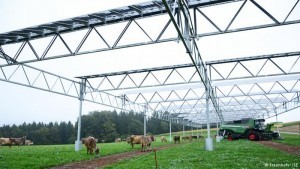Feeding the world’s growing population takes a lot of land, especially if you want to grow crops in an eco-friendly way. But space for such crops is limited. “Therefore it makes sense to double up and use available land for both the production of food and energy,” according to Petra Högy, a professor with the Institute of Landscape and Plant Ecology at the University of Hohenheim in southern Germany.
Researchers are studying the possibilities and advantages of this approach in a pilot project near Lake Constance, on the German-Swiss border, where an organic farming company is growing wheat, potatoes, celery and a mixture of clover and grass. Part of its crops are being grown under photovoltaic panels mounted on 5-meter stands, while another portion of the field is being farmed without them.
It is believed that using this comparison will reveal what kinds of vegetables or crops are suited for agrophotovoltaic (APV) production. “Based on previous simulations, we believe potatoes grow slightly better under the solar panels. Wheat, by contrast, grows slightly worse,” Högy told Deutsche Welle.
Over the next three years, agronomists will use sensors and soil samples to measure the difference in crop growth, biodiversity and crop yields, thanks to funding from the German Education and Research Ministry.
“In principle, the process is working,” said Stephan Schindele, project manager with the Fraunhofer Institute for Solar Energy Systems based in Freiburg. “Experience has shown that when it comes to agriculture, there is very little loss.”
However, despite the fact that similar sites already exist in France, Italy and Japan, systematic research on the optimal combination between crops and solar panel infrastructure has not yet been carried out.
The encouraging news is that this type of power generation costs less than for wind energy generated at sea. According to Schindele, Germany’s agrophotovoltaics potential lies at 25 to 50 gigawatts, which would meet eight percent of the country’s electricity demand.
He believes that APV production has tremendous potential worldwide, especially in sunny regions like the Middle East where solar power generation is particularly cheap and could replace diesel generators used to power agricultural water pumps.
He also believes the shadows generated by the solar panel installations –in combination with improved water technology — could offer countries in the Middle East “new possibilities for agricultural production.”
According to Schindele, Qatari farmers are now considering the idea of producing up to 30% of their own food on revitalized desert land with this new technology.
And with a combination of shade from the photovoltaic systems and seawater desalination, he actually believes it would work.
Source: Deutsche Welle
Ask me anything
Explore related questions





